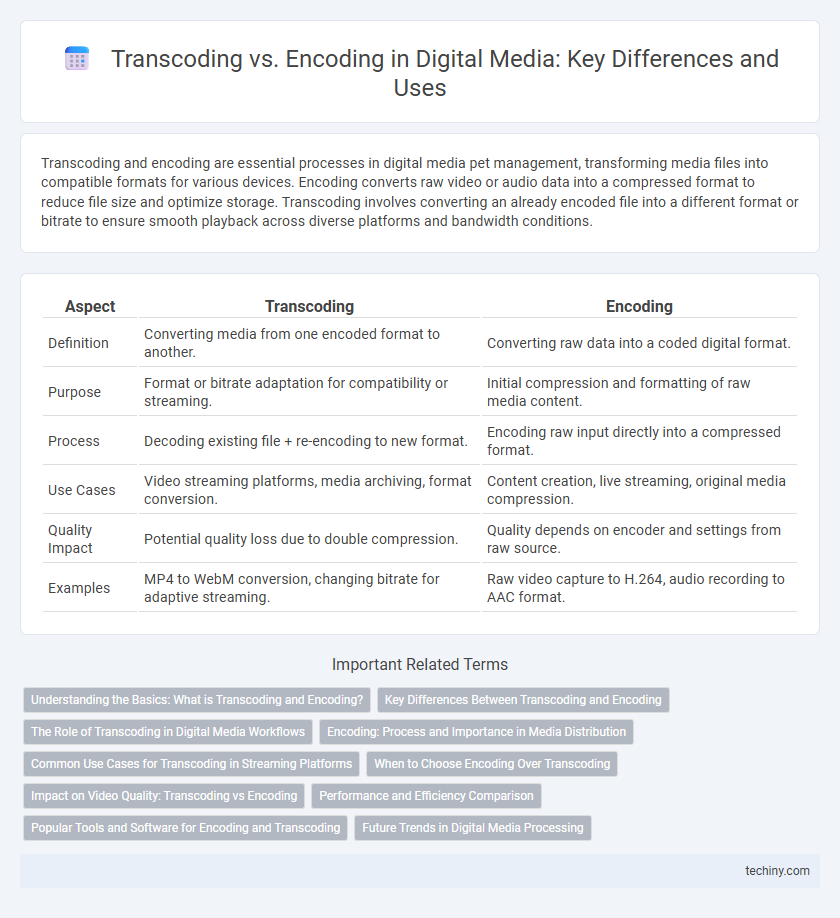Transcoding and encoding are essential processes in digital media pet management, transforming media files into compatible formats for various devices. Encoding converts raw video or audio data into a compressed format to reduce file size and optimize storage. Transcoding involves converting an already encoded file into a different format or bitrate to ensure smooth playback across diverse platforms and bandwidth conditions.
Table of Comparison
| Aspect | Transcoding | Encoding |
|---|---|---|
| Definition | Converting media from one encoded format to another. | Converting raw data into a coded digital format. |
| Purpose | Format or bitrate adaptation for compatibility or streaming. | Initial compression and formatting of raw media content. |
| Process | Decoding existing file + re-encoding to new format. | Encoding raw input directly into a compressed format. |
| Use Cases | Video streaming platforms, media archiving, format conversion. | Content creation, live streaming, original media compression. |
| Quality Impact | Potential quality loss due to double compression. | Quality depends on encoder and settings from raw source. |
| Examples | MP4 to WebM conversion, changing bitrate for adaptive streaming. | Raw video capture to H.264, audio recording to AAC format. |
Understanding the Basics: What is Transcoding and Encoding?
Encoding is the process of converting raw digital media files into a specific format using codecs to compress and optimize data for storage or streaming. Transcoding involves converting already encoded media from one format or bitrate to another to ensure compatibility across different devices or platforms. Understanding these processes is essential for effective media delivery and maintaining quality throughout distribution.
Key Differences Between Transcoding and Encoding
Encoding converts raw video or audio data into a compressed digital format, optimizing file size and playback compatibility, while transcoding involves converting already encoded media from one format or quality level to another to ensure device or platform compatibility. Encoding typically occurs once during content creation, producing the initial digital file, whereas transcoding takes place during distribution, adapting content for various streaming conditions or device specifications. Key differences include the process purpose, where encoding creates the original compressed format, and transcoding modifies existing compressed files, often impacting quality due to multiple compression stages.
The Role of Transcoding in Digital Media Workflows
Transcoding plays a crucial role in digital media workflows by converting digital media files from one format to another, ensuring compatibility across diverse devices and platforms. Unlike encoding, which initially compresses raw data into a specific format, transcoding simultaneously decodes and re-encodes media to adapt existing content for optimized streaming, storage, and playback. Efficient transcoding reduces storage costs, enhances user experience through adaptive bitrate streaming, and supports multi-platform distribution in streaming services and content delivery networks.
Encoding: Process and Importance in Media Distribution
Encoding in digital media involves converting raw video or audio data into a compressed format using codecs like H.264 or AAC, optimizing files for storage and streaming. This process ensures compatibility across diverse devices and platforms, reducing bandwidth consumption while maintaining quality. Efficient encoding is critical for seamless media distribution, enabling fast delivery and consistent playback in streaming services and digital broadcasts.
Common Use Cases for Transcoding in Streaming Platforms
Transcoding enables streaming platforms to convert video files into multiple formats and bitrates, ensuring smooth playback across diverse devices and network conditions. This process is essential for adaptive bitrate streaming, where the video quality dynamically adjusts to optimize user experience and reduce buffering. Common use cases include live streaming, video-on-demand services, and archiving content in standardized formats for future accessibility.
When to Choose Encoding Over Transcoding
Choose encoding over transcoding when creating original digital media content to ensure optimal quality and proper format compatibility from the start. Encoding is essential for converting raw footage into a compressed format suitable for storage or streaming, preserving detail and reducing file size efficiently. This approach is preferred when generating master files or preparing videos for multiple platforms that require specific codec standards.
Impact on Video Quality: Transcoding vs Encoding
Encoding establishes the original video quality by converting raw footage into a specific digital format with defined bitrate and resolution, directly affecting clarity and detail. Transcoding involves converting an already encoded video into another format or bitrate, which can introduce quality degradation due to repeated compression and potential loss of data. Maintaining high video quality requires careful encoding at optimal settings, as excessive transcoding cycles increase the risk of artifacts and reduced visual fidelity.
Performance and Efficiency Comparison
Transcoding involves converting a media file from one format to another, often requiring decoding and re-encoding, which typically demands higher processing power and longer time compared to encoding alone. Encoding compresses raw media files into a specific format and codec, optimizing storage and streaming efficiency with lower CPU utilization. Performance in transcoding is generally slower and more resource-intensive, while encoding offers greater efficiency for initial content creation and distribution workflows.
Popular Tools and Software for Encoding and Transcoding
Popular tools for encoding and transcoding in digital media include FFmpeg, HandBrake, and Adobe Media Encoder. FFmpeg supports a vast array of codecs and formats, making it a versatile choice for both encoding and transcoding tasks. HandBrake offers user-friendly presets for encoding video, while Adobe Media Encoder excels in integration with Adobe Creative Cloud applications, streamlining workflows in content production.
Future Trends in Digital Media Processing
Future trends in digital media processing emphasize AI-driven transcoding techniques that optimize video quality and reduce bandwidth consumption across diverse devices and platforms. Advances in machine learning enable adaptive encoding algorithms to dynamically adjust compression parameters based on content complexity and user playback conditions. Cloud-based distributed processing is becoming crucial for scalable real-time transcoding, supporting ultra-high-definition streaming and immersive media experiences such as VR and AR.
Transcoding vs Encoding Infographic

 techiny.com
techiny.com